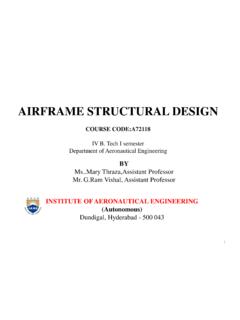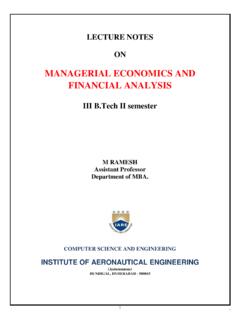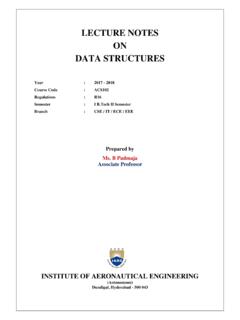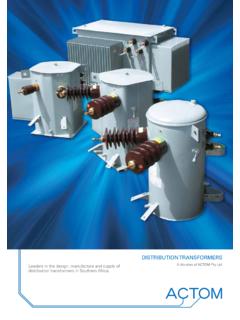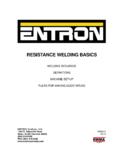Transcription of DC MACHINES AND TRANSFORMERS
1 DC MACHINES AND TRANSFORMERS . LECTURE NOTES. Dr. P Sridhar Professor & Head Department of Electrical and Electronics Engineering P MABU HUSSAIN. Assistant Professor Department of Electrical and Electronics Engineering INSTITUTE OF AERONAUTICAL ENGINEERING. (Autonomous). Dundigal 500043, Hyderabad 1|Page SYLLABUS. DC MACHINES AND TRANSFORMERS . III Semester : EEE. Course code Category Hours / Week Credits Maximum marks L T P C CIA SEE Total AEE004 Core 3 1 - 4 30 70 100. Contact classes: 45 Tutorial classes : 15 Practical classes : Nill Total Classes : 60. OBJECTIVES: The course should enable the students to: I. Illustrate the theory of electromechanical energy conversion and the concept of co energy. II. Demonstrate the working principle of different types of dc MACHINES and TRANSFORMERS .
2 III. Analyze the losses in dc MACHINES to improve the efficiency by conducting various tests. IV. Outline the principle of operation, construction and testing of single phase TRANSFORMERS . UNIT-I. ELECTROMECHANICAL ENERGY CONVERSION: Electromechanical energy conversion: Forces and torque in magnetic systems, energy balance, energy and force in a singly excited and multi excited magnetic field systems, determination of magnetic force, coenergy. UNIT-II. DC GENERATORS: Principle of operation, construction, armature windings, lap and wave windings, simplex and multiplex windings, use of laminated armature, commutator, emf equation, types of DC generators, voltage buildup, critical field resistance and critical speed, causes for failure to self excite and remedial measures; Armature reaction: Cross magnetization and demagnetization, ampere turns per pole, compensating winding, commutation, reactance voltage, methods of improving commutation; Characteristics: Principle of parallel operation load sharing, use of equalizer bars and cross connection of field windings problems.
3 UNIT-III. DC MOTORS AND TESTING: Principle of operation, back EMF, torque equation, condition for maximum power developed, types of DC motors, armature reaction and commutation, characteristics, methods of speed control, types of starters, numerical problems; Losses and efficiency: Types of losses, calculation of efficiency, condition for maximum efficiency. Testing of DC MACHINES : Swinburne's test, brake test, regenerative testing, Hopkinson's test, field's test, retardation test and separation of stray losses, problems. UNIT-IV. SINGLE PHASE TRANSFORMERS : Single phase TRANSFORMERS : Principle of operation, construction, types of TRANSFORMERS , EMF equation, concept of leakage flux and leakage reactance, operation of transformer under no load and on load , phasor diagrams, equivalent circuit, efficiency, regulation and all day efficiency; Testing of transformer: objective of testing, polarity test, 2|Page measurement of resistance, OC and SC tests, back to back test, heat run test, parallel operation, problems.
4 UNIT-V. THREE PHASE TRANSFORMERS : Three phase transformer: Principle of operation, star to star, delta to delta, star to delta, delta to star, three phase to six phase, open delta connection, scott connection; Auto TRANSFORMERS : Principles of operation, equivalent circuit, merits and demerits, no load and on load tap changers, harmonic reduction in phase voltages, problems. TEXT BOOKS: 1. P S Bimbra, Electrical MACHINES , Khanna publications, 2nd edition, 2008. 2. J B Gupta, Theory and Performance of Electrical MACHINES , S K Kataria & Sons publications, 14th edition, 2010. 3. I J Nagrath, D P Kothari, Electrical MACHINES , Tata Mc Graw Hill publications, 3rd Edition, 2010. REFERENCE BOOKS: 1. Ian McKenzie Smith, Edward Hughes, Electrical Technology , Prentice Hall, 10th edition, 2015.
5 2. M G Say, E O Taylor, Direct current MACHINES , Longman higher education, 1st edition, 1985. 3. M V Deshpande, Electrical MACHINES , PHI learning private limited, 3rd edition, 2011. 3|Page UNIT I. ELECTROMECHANICAL ENERGY CONVERSION. Electromechanical-Energy-Conversion Principles The electromechanical-energy-conversion process takes place through the medium of the electric or magnetic field of the conversion device of which the structures depend on their respective functions. Transducers: microphone, pickup, sensor, loudspeaker Force producing devices: solenoid, relay, and electromagnet Continuous energy conversion equipment: motor, generator Forces and Torques in Magnetic Field Systems The Lorentz Force Law gives the force F on a particle of charge q in the presence of electric and magnetic fields.
6 F= q(E+v B). Where, F : newtons, q: coulombs, E: volts/meter, B : telsas, v: meters/second In a pure electric-field system, F = qE. In pure magnetic-field systems, F = q(v B). Figure : Right hand rule For situations where large numbers of charged particles are in motion, Fv = (E+v B). J = v Fv =J B. (charge density): coulombs/m3, Fv (force density): newtons/m3, J = v (current density): amperes/m2. 4|Page Most electromechanical-energy-conversion devices contain magnetic material. Forces act directly on the magnetic material of these devices which are constructed of rigid, non-deforming structures. The performance of these devices is typically determined by the net force, or torque, acting on the moving component. It is rarely necessary to calculate the details of the internal force distribution.
7 Just as a compass needle tries to align with the earth's magnetic field, the two sets of fields associated with the rotor and the stator of rotating machinery attempt to align, and torque is associated with their displacement from alignment. o In a motor, the stator magnetic field rotates ahead of that of the rotor, pulling on it and performing work. o For a generator, the rotor does the work on the stator. The Energy Method > Based on the principle of conservation of energy: energy is neither created nor destroyed; it is merely changed in form. > Fig. shows a magnetic-field-based electromechanical-energy-conversion device. - A lossless magnetic-energy-storage system with two terminals - The electric terminal has two terminal variables: e (voltage), i (current).
8 - The mechanical terminal has two terminal variables: ffld (force), x (position). - The loss mechanism is separated from the energy-storage mechanism. Electrical losses: ohmic Mechanical losses: friction, > Fig. : a simple force-producing device with a single coil forming the electric terminal, and a movable plunger serving as the mechanical terminal. - The interaction between the electric and mechanical terminals, the electromechanical energy conversion, occurs through the medium of the magnetic stored energy. 5|Page - Wfld : the stored energy in the magnetic field - From the above equation force can be solved as a function of the flux and the mechanical terminal position x. - The above equations form the basis for the energy method Energy Balance Consider the electromechanical systems whose predominant energy-storage mechanism is in magnetic fields.
9 For motor action, the energy transfer can be accounted as The ability to identify a lossless-energy-storage system is the essence of the energy method. This is done mathematically as part of the modeling process. For the lossless magnetic-energy-storage system of Fig. can be rearranged and gives Here e is the voltage induced in the electric terminals by the changing magnetic stored energy. It is through this reaction voltage that the external electric circuit supplies power to the coupling magnetic field and hence to the mechanical output terminals. 6|Page The basic energy-conversion process is one involving the coupling field and its action and reaction on the electric and mechanical systems. Combining above two equation . Energy in Singly-Excited Magnetic Field Systems In energy-conversion systems the magnetic circuits have air gaps between the stationary and moving members in which considerable energy is stored in the magnetic field.
10 > This field acts as the energy-conversion medium, and its energy is the reservoir between the electric and mechanical system. Fig. shows an electromagnetic relay schematically. The predominant energy storage occurs in the air gap, and the properties of the magnetic circuit are determined by the dimensions of the air gap. 7|Page On path 2a, d =0 and ffld=0. Thus dffld=0 on path 2a. On path 2b, dx=0. Therefore the following equation will result For magnetically linear systems the energy and co-energy are numerically equal Graphical representation of energy and co-energy in singly excited magnetic field system is shown below. Figure: Graphical representation of energy and co-energy 8|Page Multiply Excited Magnetic Field Systems: Figure: Doubly excited magnetic field system 9|Page 10 | P a g e UNIT II.
